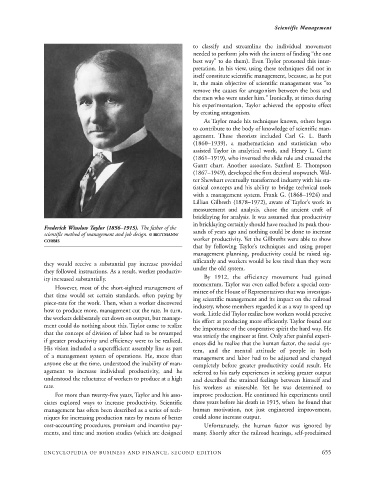Page 678 - Encyclopedia of Business and Finance
P. 678
eobf_S 7/5/06 3:21 PM Page 655
Scientific Management
to classify and streamline the individual movement
needed to perform jobs with the intent of finding “the one
best way” to do them). Even Taylor protested this inter-
pretation. In his view, using these techniques did not in
itself constitute scientific management, because, as he put
it, the main objective of scientific management was “to
remove the causes for antagonism between the boss and
the men who were under him.” Ironically, at times during
his experimentation, Taylor achieved the opposite effect
by creating antagonism.
As Taylor made his techniques known, others began
to contribute to the body of knowledge of scientific man-
agement. These theorists included Carl G. L. Barth
(1860–1939), a mathematician and statistician who
assisted Taylor in analytical work, and Henry L. Gantt
(1861–1919), who invented the slide rule and created the
Gantt chart. Another associate, Sanford E. Thompson
(1867–1949), developed the first decimal stopwatch. Wal-
ter Shewhart eventually transformed industry with his sta-
tistical concepts and his ability to bridge technical tools
with a management system. Frank G. (1868–1924) and
Lillian Gilbreth (1878–1972), aware of Taylor’s work in
measurement and analysis, chose the ancient craft of
bricklaying for analysis. It was assumed that productivity
in bricklaying certainly should have reached its peak thou-
Frederick Winslow Taylor (1856–1915). The father of the
sands of years ago and nothing could be done to increase
scientific method of management and job design. © BETTMANN/
worker productivity. Yet the Gilbreths were able to show
CORBIS
that by following Taylor’s techniques and using proper
management planning, productivity could be raised sig-
nificantly and workers would be less tired than they were
they would receive a substantial pay increase provided
under the old system.
they followed instructions. As a result, worker productiv-
ity increased substantially. By 1912, the efficiency movement had gained
momentum. Taylor was even called before a special com-
However, most of the short-sighted management of
mittee of the House of Representatives that was investigat-
that time would set certain standards, often paying by ing scientific management and its impact on the railroad
piece-rate for the work. Then, when a worker discovered industry, whose members regarded it as a way to speed up
how to produce more, management cut the rate. In turn, work. Little did Taylor realize how workers would perceive
the workers deliberately cut down on output, but manage-
his effort at producing more efficiently. Taylor found out
ment could do nothing about this. Taylor came to realize
the importance of the cooperative spirit the hard way. He
that the concept of division of labor had to be revamped
was strictly the engineer at first. Only after painful experi-
if greater productivity and efficiency were to be realized.
ences did he realize that the human factor, the social sys-
His vision included a superefficient assembly line as part tem, and the mental attitude of people in both
of a management system of operations. He, more than management and labor had to be adjusted and changed
anyone else at the time, understood the inability of man- completely before greater productivity could result. He
agement to increase individual productivity, and he referred to his early experiences in seeking greater output
understood the reluctance of workers to produce at a high and described the strained feelings between himself and
rate. his workers as miserable. Yet he was determined to
For more than twenty-five years, Taylor and his asso- improve production. He continued his experiments until
ciates explored ways to increase productivity. Scientific three years before his death in 1915, when he found that
management has often been described as a series of tech- human motivation, not just engineered improvement,
niques for increasing production rates by means of better could alone increase output.
cost-accounting procedures, premium and incentive pay- Unfortunately, the human factor was ignored by
ments, and time and motion studies (which are designed many. Shortly after the railroad hearings, self-proclaimed
ENCYCLOPEDIA OF BUSINESS AND FINANCE, SECOND EDITION 655

